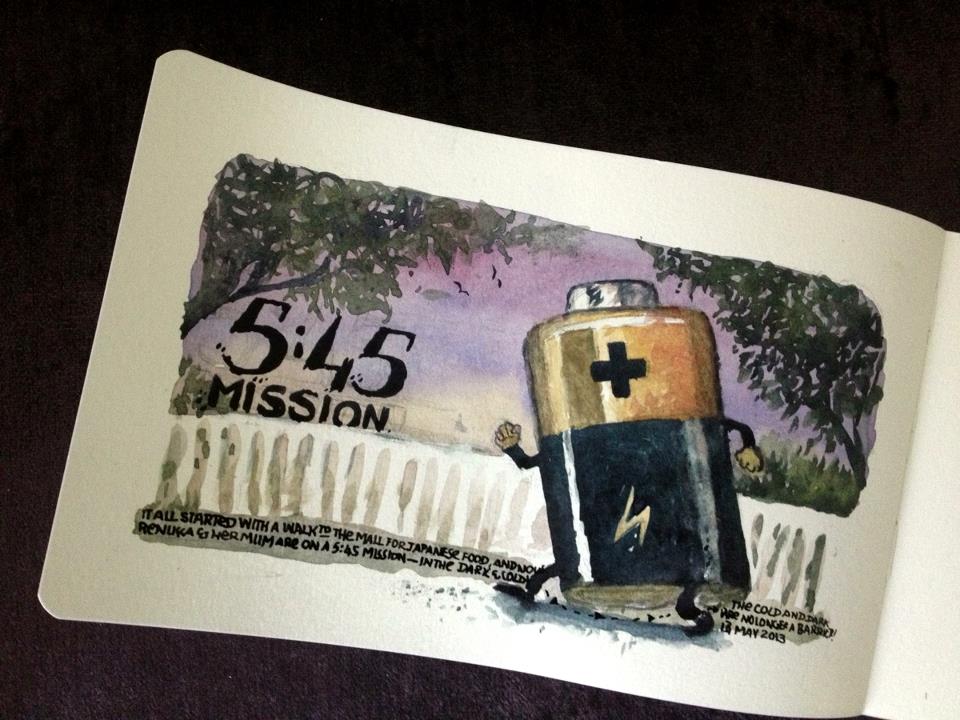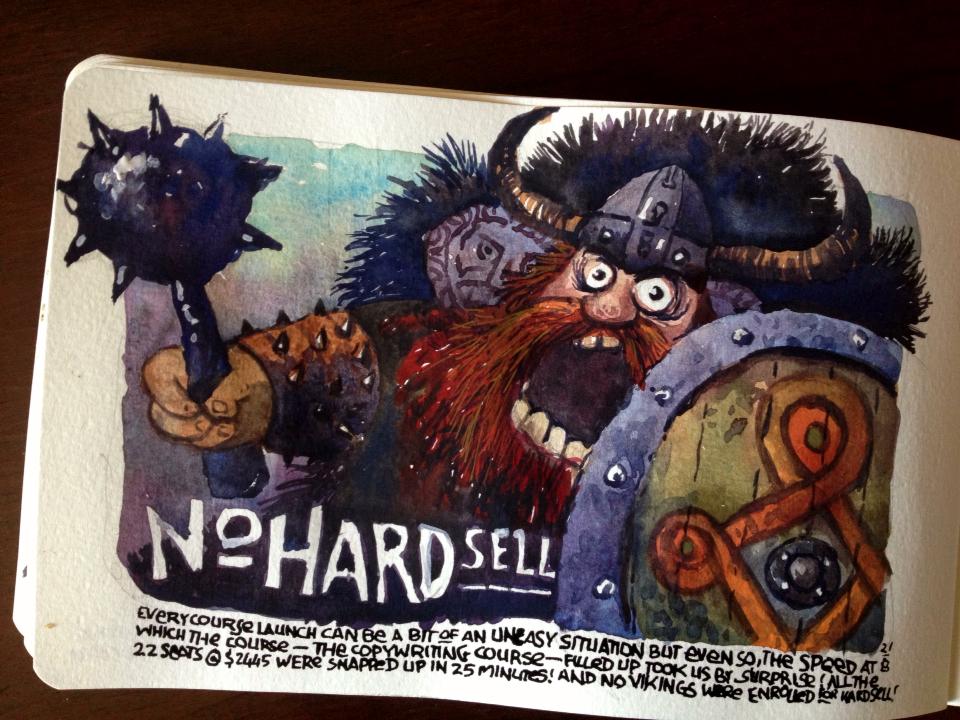Small Business Marketing: Sean D’Souza Tells Us Which ideas Work and Why
Sean D’Souza is a brilliant marketer & cartoonist. I have known him for quite some time & have received great insights from him for my business from time to time. I am glad he agreed to get interviewed by me on some relevant personal & professional questions. He has shared his ideas in immaculate detail. You might just end up saying eureka after reading it!
Q. Please tell us something about yourself.

I started out in advertising as a copywriter in Leo Burnett (one of the world’s largest ad agencies). I became a full time cartoonist, before finally starting up Psychotactics.com in 2002. I have written and published hundreds of articles on the topic of why customers buy and why they don’t. Our Psychotactics newsletter carries small business marketing ideas and psychological insights into the marketing process.
Q. Why do small business marketing ideas have to be different from typical marketing ideas?
Large businesses have relatively larger budgets and resources. Small businesses rarely do. So they have to use completely different marketing strategies and tactics. But let’s talk about resources to begin with. A small business might have as few as one person working on several projects, whereas a big business might have a team of 20 people or more. So the resources are already in place for a bigger business and so is their budget. A small business has to rely on an extremely low-budget, and make sure that they get similar if not equal impact as a large business.
Q. How should small business owners choose their marketing ideas?
A small business owner should always choose their marketing ideas based on how long they can sustain that idea. The problem with marketing today is that there is too much noise in the marketplace. But even if you go back 50 or hundred years, the same principle applied.
This principle is one of being able to sustain a marketing idea over a long duration of time. So for instance, at Psychotactics.com, we’ve had to work with strategic alliances as they have been the biggest source of clients — an extremely high quality clients. So you have to focus on a single idea and keep going with that idea over a sustained period.
If you keep chasing after every idea that pops up in the marketplace, then you simply do not have the resources to manage all of those ideas. As a result, almost all the ideas fall apart and the marketing comes to a standstill. So whenever you choose an idea, the first question to ask yourself is: can I do this for the next 10, 20, 30 years? If the answer is yes, then that is the kind of idea that you need to choose in your marketing.
Of course you may wonder if it is a good idea or if there is a better idea coming up along the way. The point is that pretty much any marketing strategy will have a good impact if you sustain it. Almost every marketing concept has been tested for hundreds even thousands of years, so we know that the ideas work.
You don’t have to choose a brilliant idea, you just have to make sure that you sustain the pressure and get results from that one idea. Once that idea has gained momentum, you can add a second strategy to it, and then a third. But often you don’t need more than a couple of them to keep a business very successful. In fact if anything, a business that chases after half a dozen or a dozen ideas is the one that loses out.
Q. Do you think small businesses should only look at free or cheap marketing options? Why?
This is an interesting question. Marketing options may seem cheap, but they are not always successful. In our experience, it’s not so much the execution that matters. So for instance if you were to create a brochure or a website, it’s not always very expensive as a marketing option. However, the learning process is expensive. So to get an outstanding brochure, you have to learn how to create elements of persuasion that drive the customer to your business.
This learning process takes time and often costs a lot of money — especially if you go to people who know what they are doing and do it extremely well. A small business would need a reasonable mastery over article writing, website components, copywriting etc. All of these elements help the business surge ahead as they don’t have to then depend on outsourcing all the time.
Often a small business has to get moving very quickly — and this is the prime reason why they need to have the skills. There is nothing wrong with outsourcing, but it takes a lot of effort and time. Even if you get a skilled copywriter, article writer etc.
A small business owner has to often move extremely quickly and there is no time to go through an entire process of contacting a professional, giving them a brief, seeing drafts etc. Everything may need to be done in a few days, and having mastery over these skills — or at least a huge amount of control over the skills, becomes the more effective option. So yes, it’s not cheap or free to begin with, but as you get more control over the skills it becomes cheaper in the long run. And more importantly, you have huge control over what you are doing as a small business owner.
Q. What are some things that small businesses can do better than their larger counterparts?
One of the best things that a small business owner can do better than their larger counterparts is to drive home their uniqueness. Today we think of Google as a massive company, but remember that Google was tiny to begin with. Yes they did things differently, but it’s their uniqueness that got them into this position.

They communicated their uniqueness to their audience and people switched over from Yahoo and other search engines that they had been using for years. Google did it all over again with Gmail. People had been using Hotmail and other email providers for years, and yet Google created a uniqueness factor. Small business owners can learn from this uniqueness factor. Even if you are an extremely tiny business, you have huge advantages that larger businesses cannot cope with.
For them to get the uniqueness message out, they would have to sit in a board meeting and go through several weeks or months of deliberation. A small business owner can create and promote their uniqueness in a matter of days — and then drive that uniqueness home time after time. This would enable that small business to be extremely successful even in the face of incredible odds. Customers don’t choose products based solely on a brand, but more so on how that product or service satisfies their specific need.
Large business tries to get everyone and is often vague (think of a bank marketing, for instance). A smaller business on the other hand, may have greater disadvantages in terms of resources and revenues, but if they drive home their uniqueness, they can pick up customers at will.
For instance, we have an article writing course that we conduct annually. If you look on the Internet, you will find both big and small businesses that may have a course that is similar to ours. Well, it looks similar to ours to the customer anyway. However, we have a uniqueness of our course being “the toughest writing course in the world”. Before we put that uniqueness in place, it would take weeks and even months to fill up the course — and at half the price that we charge now.
We have more than doubled our prices and yet the course fills up in less than an hour — once we have made the announcement. There are several marketing elements in play when you consider filling up a course, but uniqueness plays a big role in getting the customer to buy your product or service even when there are cheaper products of service around. And so in this way a small business can do better than their counterparts — and the counterparts are never able to catch up.
Q. Tell us something about the up-scaling of customers from a small value sale to a higher value sale that you practice. How can single product companies apply this process to increase their ticket size?
The biggest factor in purchasing any product or service is always risk. About 100 years ago, the same problem existed. Products were not branded and customers didn’t know which product was superior to the other — or even if they were getting a product of outstanding quality.
Branding solved that problem to some extent because now the customer trusted the brand and hence bought the product. However, today we have a similar problem, but a problem of over branding. So as you go online, you get thousands of people selling what seems to be a similar product or service. And you’re not sure who to trust. So the method that we use is to try out a small option first.
Most businesses don’t have a small option. Take service business for instance, and you will find that there is no small option. Their first option might be a service that costs $2000 per transaction. The customer is reluctant to go ahead with such a deal even if there is some sort of risk reversal in place.
They would prefer to have some sort of smaller service that they could test before they go ahead. The same applies to products such as information products. If you would have only larger products or more expensive products, then the customer is reluctant to make a buying decision. It’s not that they don’t want to buy from you, it’s just that they want to test the waters first.
The way around this is to have twofold programs in place. The first programme is one of smaller, niche products. The same can be done for services, but I will stick to products for now. So at Psychotactics, we have smaller niche products like “website components”.
A product like this shows a client how to write a great homepage, about us page etc. Or we may have a product like “the secret life of testimonials”. Now these products are not necessarily $10 and many of them might be as much as $35-$45, but they are still within the testing range of the customer. The risk isn’t extremely high, so they will make the leap and buy the product.
Because it tends to be a smaller product, the consumption is also extremely high. Bigger products like courses need more time to go through, and a smaller product can be quickly consumed by the customer and then they come back for more. They don’t go to the bigger products right away, but continue to buy smaller products on a consistent basis.

So a customer may spend several hundred dollars at Psychotactics before they decide to buy a bigger product like The Brain Audit or membership of 5000 BC. However, this is true if you have several products going. Remember that we do started out with a single product and then clients ask for more products in you create them. But getting back to the point of a single product, even that can be achieved by using the second method of sampling.
Even at Psychotactics, we find that some customers will go for a larger product the first time around. That is to say that they haven’t bought any smaller products and yet they buy a big product right away. But have they really bought it right away? The answer is in most cases, no. Instead they have gone around sampling other products.
On our site, we have several giveaways. But these giveaways have to be produced in a way so that they appear to be complete products, or are complete products. We give away a workshop for instance, and several excerpts of books, or they might be smaller reports.
Even if a company has a single product, they can quite easily put together small reports of not more than 8 to 10 pages each. For instance, we have a report that about 10 pages which is called the headline report. This was put together from an article that was extremely popular on our website. So it wasn’t even specifically written as a report.
This interview for instance could be a report. It could have 10 questions and if you were to put this into a PDF or into an audio or video, it would become extremely valuable to the customer. But more importantly it would serve as a sampling mechanism. Once the customer is convinced that you are able to deliver value and know what you’re talking about, they will then jump right into buying a larger product.
However, in the long run your goal should be to create several products and not to be a single product company. This is because the customers have gone through an enormous amount of trouble to choose you over your competition.
They now trust your judgment and your ability. They don’t really want to go through the whole process of finding a new supplier to satisfy their needs. When you do not create several products, you are effectively driving them into the hands of the competition.
The customer doesn’t like this, and obviously you don’t like it either when they leave. There are several reasons why customers leave. But one of the biggest reasons would definitely have to be that they are not getting enough support from you. This is not to say as if you go about creating products all the time, but you need to have a definite consistency in creating products and services that meet the needs of your customers.
Q. You were a cartoonist in the earlier part of your career and still do cartoons. What is the role of fun and humor in marketing successfully?
Personally I think it plays an extremely big role. For one, it’s quite unique because it relaxes the reader. We put cartoons in all our books, reports, workshops etc. These cartoons are extremely effective in driving home the point.

They don’t necessarily have to be humorous, but cartoons by virtue of being cartoons are exaggerated. Remember that cartoons never stand alone. There is always a caption that accompanies them and the caption is what drives home the message. So the cartoon is never just decorative, but is there to propel your message forward in a non-boring manner.
The cartoon is more effective than any other media because it’s very hard to get photography to replicate several situations. If for instance you want to show how a hard disk can crash and you can lose all your data, it is very hard to show that effectively through a photograph. However you can just imagine a person on the rooftop and a swift breeze comes along and blows away all their sheets into the street.
Now that message is instantaneous and the customer gets it. Illustrations can do part of this job, but cartoons have the power of exaggeration that are quite hard to replicate through photographs or through illustrations.
If you use cartoons well, people warm up to them quite quickly. This is because we have grown up reading cartoons and are familiar with how they work. Yes, there will be customers who think that cartoons make your business frivolous, but remember that one of the most serious magazines on the planet — the Economist, also uses cartoons. It’s not just the usage of cartoons, but also how you use them that matters.
Q. You have published a book recently. Please tell us who should get that book and how.
A book? We have published several books, but one of the recent books is on the topic of pre-sell. It is a concept of “how to get customers to buy, long before they pay”. We have other books as well, but one book that is available in almost every medium is The Brain Audit. Of course we recommend that you buy the more “expensive” version at the Psychotactics site itself.
This is because you get the greatest value including a full workshop for a very reasonable price. But should you choose to just test the waters, it’s also available as a printed book or on Amazon Kindle. So yes, The Brain Audit would be a good start for those who want to understand how customers think. The critical element of marketing is to understand why customers buy — and why they don’t. I would say that there are dozens of books, if not hundreds on why customers buy, but The Brain Audit goes into why they don’t buy as well, which is what makes it unique.
Q. Why do you call your newsletter “Psychotactics newsletter”? How can one subscribe to this?
It’s a long story. We had a terrible name at first, but at some point a friend recommended that I call it the Psychotactics newsletter. It appealed to me because it had the term “Psycho” which in pretty much any language means crazy.
That kind of appeals to my sense of humour, but it’s also been a great curiosity factor on search engines. If you’re faced with several marketing sites and one of them is slightly “psycho”, then you are more likely to click on that link.
However, the site was called Psychotactics because it dealt with psychological tactics. When you squish up psychological tactics, you get Psychotactics. And that is the short story of how we named it the Psychotactics newsletter. You can subscribe to it by simply going to Psychotactics.com and reading more about how it can help your small business.
Hope you enjoyed the discussion with Sean about marketing your small business. Please share your feedback and comments by posting a comment below.